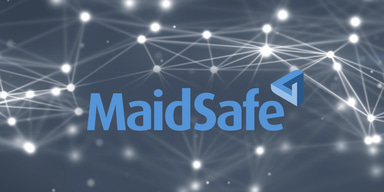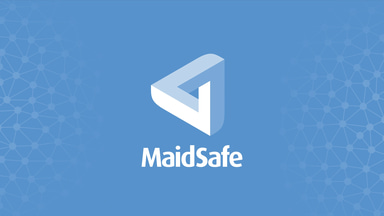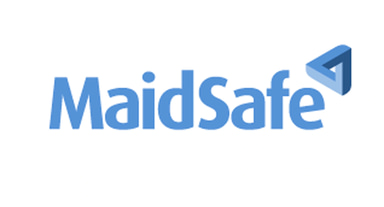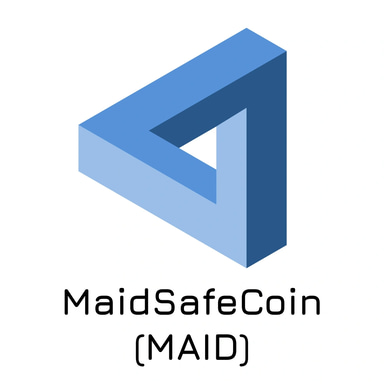Read
Edit
History
Notify
Share
MaidSafeCoin
MaidSafeCoin is a cryptocurrency of the autonomous and decentralized data network known as SAFE Network. It was launched in 2014 and aims to decentralize all the Internet resources and services such has unused hard drive space, processing power and bandwidth or unused network access, by removing centralized servers and other central points of weakness enabling privacy, security and anonymity to all Internet users. The users who provide those services are paid currently in MAID token for their excess resource.[7][8]
Company
The SAFE network is developed by the UK-based organization, MaidSafe. It is a small company comprised of thinkers, inventors, tinkerers, Ph.D holders engineers, and designers. It was founded by Scottish engineer and entrepreneur, David Irvine in 2006, with a mission to provide security and privacy for everyone by building a better internet platform.
The company has its headquarter at Ayr, South Ayrshire, GB and has around 11-50 employees.[9]
Notable Team members include -
| Name | Designation | Ref |
|---|---|---|
| David Irvine | Executive Directors | |
| David Allan | Non- Executive Director | |
| Andy Laverty | Non Executive Director | |
| David Cosh | Non Executive Director | |
| Fraser Hutchison | Developer | |
| Stephen Coyle | Test and Release Manager |
Fundraising
Maidsafecoin has raised total 7.6 million USD over 2 rounds since 2014. It raised total 6million USD in crowd sale via IPO in April 2014. Buyers were allowed to purchase MAID using Bitcoin and Mastercoin. In October 2016 MaidSafe held their second round of equity crowdfunding campaign raising $1.6 million USD in funding.
Overview
MaidSafecoin name is acronym of Massive Array of Internet Disks (MAID) and + Secure Access For Everyone (SAFE). Safecoin is the cryptocurrency of the SAFE network. It was launched in first April 2014 with a proxy token MAID. Once Safe network goes live, the MAID tokens will be replaced by Safecoin.[10]
SAFE Network
The SAFE (Secure Access For Everyone) Network, is a peer-to-peer decentralized data and communications network designed and built by MaidSafe and it is currently in the implementation phase. In today's internet era, the data centers and servers are prone to data theft and surveillance. The Safe Network provides next generation decentralized and secure network that will compliment all existing centralized web services and data centers with a secure and anonymous network comprised of the spare computing resources of its users. It uses advanced peer-to-peer technology that joins together the spare computing capacity of all Safe users, creating a global network.
The Safe Network includes the unused hard drive space, processing power and data connection of its users. It will enable the next level of security and privacy not currently available on the existing Internet and turns the tables on companies, putting users in control of their data, rather than trusting it to organizations. The users can earn Safecoin by providing your their unused computing resources to Safe network.[11][12]
How Safe Network works?
The clients and farmers are the two main users in secure, autonomous, data-centric, peer-to-peer SAFE network. The clients are the users who use the various features of the network, such as browsing, storing data, or transferring money. The farmers store and look after user data and they might receive a reward for their efforts. The SAFE network is an encrypted layer which complements current server based internet structure and sits on top of it. It allows autonomous data storage and networking by replacing three” of the OSI model networking layers.
Data Encryption
As mentioned, the SAFE network is an encrypted layer on traditional internet structure and when user wants uploads any data file to the network, it will be broken into pieces, hashed, and encrypted. The data is then randomly distributed across the network and redundant copies of the data are created to prevent data loss. So even if the computer/ HDD storing user file goes offline or becomes unavailable, the user will still have access to their his/her data. The network is designed to automatically create more copies of data that is in high demand, so popular content and websites will have more copies of their data and eventually it will help to speed up current system.
The Safe network uses AES -256 algorithm to encrypt data. The hash function will map any piece of data to a 256-bit string of characters. The network will perform the XOR operation on the hash value to randomly create a unique (mathematical) distance to any other piece of data. XOR is simply converting two hashes into binary and comparing the bits. If the bits match, the output will be 0. If the bits don’t match, the output is 1. The XOR distance between data and the ability to randomly assign data to a certain location is relevant to the Close Group Consensus, the innovation used by MaidSafe in place of a blockchain.[13][1]
Vaults and Farmers
Despite complementing centralized systems, the data is stored in a decentralized manner in SAFE network. It secures data by hashing, encrypting, and distributing across the network rather than storing at one place. This distributed data is managed by software called as Vault. It connects users to the SAFE network and saves the distributed pieces of data on the computer. The people running the vault software are referred to as farmers.
Anyone can become a farmer and provide their resources to the SAFE network provide their resources meet the minimum requirements. The user's CPU power and bandwidth capability will be checked via proof of resource request. If user qualifies to become farmer accepted, he/she will be assigned pieces of data close to each other in XOR space to store in his/her vault. Their extra storage space on your hard disk and computing power are used to power the network.
Incentives
The farmers will earn safecoins for providing their storage, bandwidth and other resources. When a client wants to access a piece of data on the SAFE network, such as a website or a file, the farmers will compete to find the relevant pieces of data and deliver them to the client. The farmer who delivers that data first will have a chance to earn some Safecoin. When a farmer completes with his proof of resource, his will generate the name of a random Safecoin on the network. If that coin is already owned by someone, then this farmer simply receives no reward. However, if he generates the name of a coin with no owner, it’s yours.
Since the Safecoins are required to upload data to the SAFE network and use applications, Maidsafe team hopes the coins will have value and so to incentivize miners/farmers to provide their extra resources to the network. The SAFE network also enables trading of safecoin with free and instant exchange of it as a currency.
Proof of Resource
The consensus mechanisms used in SAFE network is Proof of Resource (PoR). In this, the network continually mathematically validates the proof the farmer or users provides. The network tries to mathematically verify user identity and the resource proof he has provided. The network does this by attempting to store and retrieve data chunks onto/from its nodes. The ability for a node to carry out these actions will be determined by a combination of its CPU speed, bandwidth availability, unused storage capacity and on-line time. The SAFE Network uses a Zero-knowledge proof mechanism, where the network does not require to know the content of any data to be checked, but it requires to know that the data is in fact stored in a accurate manner. Nodes priority is decided on rank basis and the nodes that are either unreliable or are trying to play game the network, by removing previously provided resource, will be de-ranked by the network if they fail to serve a chunk of data.
The Transaction Managers
The Transaction Manager is a role carried out by the SAFE Network's vaults. Vaults not only store data on a farmer's computer and consist of a series of processes including management of the storage of data and other vaults, but it's most important job is to manage the processing and completion of safecoin transactions. The SAFE Network uses a closed group of consensus to reach a decision point. In this, close groups of 32 nodes is formed and the transaction manager is the trusted group closest to any given transaction identity. These close groups are chosen by the network based on the closeness of their IDs to the ID of the safecoin. Closeness in this respect refers to the XOR (mathematical) distance as opposed to geographical closeness.
In technical words, The hashing function can result in 2 to the power of 256 different addresses. These addresses are split into sections and managed by different groups of vaults. The most trusted vaults in the group, the Elders or Transaction Manager, are required for forming a consensus on important decisions such as splitting up groups, merging with other groups, or handling Safecoin transactions. Vaults always share data with the vaults nearby in XOR space so that the network can be reformed. So if the computers in one group shuts down, the vaults near that group can reconstruct the lost information and keep the network up.
The data and safe coin transfer both are atomic in the Safe network. It uses a cryptographic signature to demonstrate that the last person who owned the safecoin has signed the coin over to the current owner. When the current owner spends the coin, they ask the network (their close group of 32) to accept a signed message transferring ownership to the new owner. The knowledge of coin ownership (each has their own unique ID) is kept in several close groups and each group must agree upon and reach consensus (28 of 32) on the transfer of ownership before the transaction is processed and the ownership of the coin is transferred.
Safecoin
The safecoin is the cryptographic token of the SAFE Network, It is designed to incentivize network participants or different users and contributors to the network. Safecoins can only exist on SAFE and it's distribution is handled entirely by the network on a per use basis. It is anticipated that 4.3 billion coins will be produced during the life of the network. Each safecoin will have it's own unique identity and will be required to access services on the Safe Network. The type of services that will be available on the network will be developed by third party developers. The services that are accessible on today's centralized systems will also be available on the SAFE Network. The cost for these services will be set by the service provider/ developer and and it is anticipated expected that as more and more competing apps will be developed in future.
Safecoin Minting
The generation of safecoin is entirely network led and they are only created as the network is used and data retrieved from network nodes. Minting safecoin will be available when Safe Network goes live. Minting can be achieved by the network, enabling the registration of a special transaction with the transaction managers, that facilitates transfer of the ownership of the coin to any user that acknowledges the transaction. The minting process effectively removes the requirement for the transaction validation step from the Transaction Manager.[14]
For example, When Alice wants to mint safecoin, she sends a request to the Transaction Managers with a special request to transfer the coin(s) to anyone. Once The Transaction Managers confirm using consensus that Alice is the current owner, they generate the transaction. So then Alice receives the transaction name from the network and she can store it anywhere including on an external storage device, together with a special validation signature which has been used as a salt when generating the previous sent request1 . This salt is used to prevent Transaction Managers themselves trying to acknowledge the transaction to steal the coin from John. When Bob receives the minted safecoin and decides he would like to spend them, he reads the transaction name and the validation signature from the storage device and then sends an acknowledgement to the network. Once the Transaction Managers receive the acknowledgement, the pre-generated transaction will be updated, thus completing the transfer of ownership of that coins from John to Sandra.
The method reduces the complexity of the transaction and makes minted safecoin similar to a cash note. It also means that user no longer needs to worry about keeping his private key safe as the transaction has been pre generated. Minted safecoin will also be more anonymous, eliminating the need to store safecoins only in a digital wallet that can be compromised. The risk involved in this method is that after the transfer transaction has been generated and registered, if the owner loses the storage device containing those safecoins, anyone will be able to claim ownership.
Roadmap and Development
According to announcement in 2019 in the Maidsafe forum, The safe network development is divided into 4 stages. The network is approaching beta.
-
Overall view of backend roadmap : It contains a summary of key pieces of work required in a kanban-style. The chunks of work are contained within columns which relate to key network release milestones. During this phase, During this time, the team used Preview Network(s) to test new features. The purpose of these Preview Networks was to test out new frontend and backend features that would otherwise be incompatible if they were to be introduced to the current live network or the network in progress.
-
Overall view of Frontend/UX roadmap : The Safe network development is in this phase currently and the parts of the Network that the SAFE user interacts with do not neatly fit within the key milestones (Fleming, Maxwell, etc.). Whilst there are dependencies (e.g. the release of Test Safecoin to use the Wallet), this work can continue in many cases in parallel with progress by the backend team. The team has separated the frontend and backend roadmaps to avoid confusion. Currently, Baby Flamingo Release iteration 3 is around the corner.
-
Task level board showing the most immediate tasks: This board provides a slightly more detailed view for those who are interested. Timescale and details are not finalized.
-
30,000 foot view of Roadmap across entire Network - TBD
Tokenomics
Safecoin (SAFE)
According to whitepaper, SAFE cryptocurrency will be a native token of the SAFE network once SAFE network mainnet goes live. The users will be allowed to swap their MAID tokens in a 1:1 ratio to SAFE. The total supply of the Safecoin is not set, but It is anticipated that 4.3 billion Safe coins will be produced during the life of the network. Furthermore Safecoins will be "recycled" when they are being exchanged for network services, so there will be a new supply of coins for users to earn.
Maidsafecoin (MAID)
Maidsafecoin is a proxy token that was released during MaidSafe's crowd sales in 2014 and 2016 and the MAID holders will be allowed to swap MAID for SAFE tokens in 1:1 ratio in the future. MAID token is created using an open-source, decentralized asset platform, Omni. It is a platform for creating and trading custom digital asset and currencies. It is a software layer built on top of the Bitcoin blockchain. The current circulating supply of MAID is 452,552,412 MAID on March 13, 2021. It registered all time high of $1.20 USD on Jan 02, 2018 and all time low of $0.004059 USD on Mar 08, 2015.It is available to trade on HitBTC and Bittrex cryptocurrency exchanges. In the past, it was available on Poloniex as well.[15]
MaidSafeCoin
Commit Info
Feedback
Average Rating
How was your experience?
Give this wiki a quick rating to let us know!
Twitter Timeline
Loading
Media






REFERENCES
[1]
[2]
[3]
[4]
[5]
[6]
[7]
[8]
[9]
[10]
[11]
[12]
[13]
[14]
[15]
